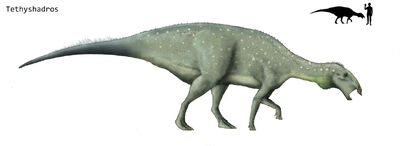
Tethyshadros insularis is an extinct genus of hadrosaur dinosaur that lived in Italy during the Late Cretaceous period.
Discovery and naming[]
The genus was named and described by Italian paleontologist Fabio Marco Dalla Vecchiain 2009. Its only and type species is Tethyshadros insularis. The genus name refers to the Tethys Ocean and the Hadrosauroidea. The specific name means "insular" or "of the island" in Latin, a reference to the location of the discovery of the type specimen on the Adriatic-Dinaric Island, one of the larger islands of the European Archipelago.
Tethyshadros is based on holotype SC 57021, a mostly complete but crushed skeleton, that had previously been nicknamed "Antonio," as well as a few referred specimens. The growth lines of the bones indicate that the holotype was perhaps five to six years old.
"Antonio" was found at the Villaggio del Pescatore site in the Province of Trieste, near Duino-Aurisina. This site was discovered in the 1980s by Alceo Tarlao en Giorgio Rimoli in an old quarry near the sea. Here, layers are exposed from the Liburnia Formation, from the Campanian-Maastrichtian ages, which occurred 70-71 million years ago. In them a chalkstone lens was present, containing fossils and measuring ten metres thick and seventy metres in diameter. In 1994 student Tiziana Brazzatti discovered the hand bones of a larger skeleton. Stoneage, a company dealing in fossil collection, was commissioned to retrieve any remains, for which an overburden of three hundred tons had to be removed. Paleontologist Dalla Vecchia was later brought in to provide professional guidance. In April 1999 "Antonio" was removed from the quarry, being slightly damaged by the process.
Description[]
With a length of about 4 metres (13 ft) and a weight of 350 kilograms (770 lb), Tethyshadros is a relatively small species. Dalla Vecchia has hypothesized that this is an instance of insular dwarfism. The skull is relatively long, the neck and tail short. The legs, especially the shin bones, are long. These proportions, combined with a reduction of the number of fingers, are seen as cursorial adaptations for bipedal running.
Tethyshadros shows a mix of basal and derived traits. A cladistic analysis indicates that it was closely related to the Hadrosauridae sensu Sereno and Telmatosaurus. According to Dalla Vecchia, the presence of Tethyshadros on a European island is caused by a radiation of basal hadrosauroids, island-hopping from Asia. He rejects the possibility that the species is a relict of isolated evolution from earlier European hadrosauroids or descended from American hadrosaurs.
In December 2, 2021, an adult specimen has recorded in Italy as a dinosaur treasure trove to rewrite the history, geography, and evolution of the ancient Mediterranean area.[1]